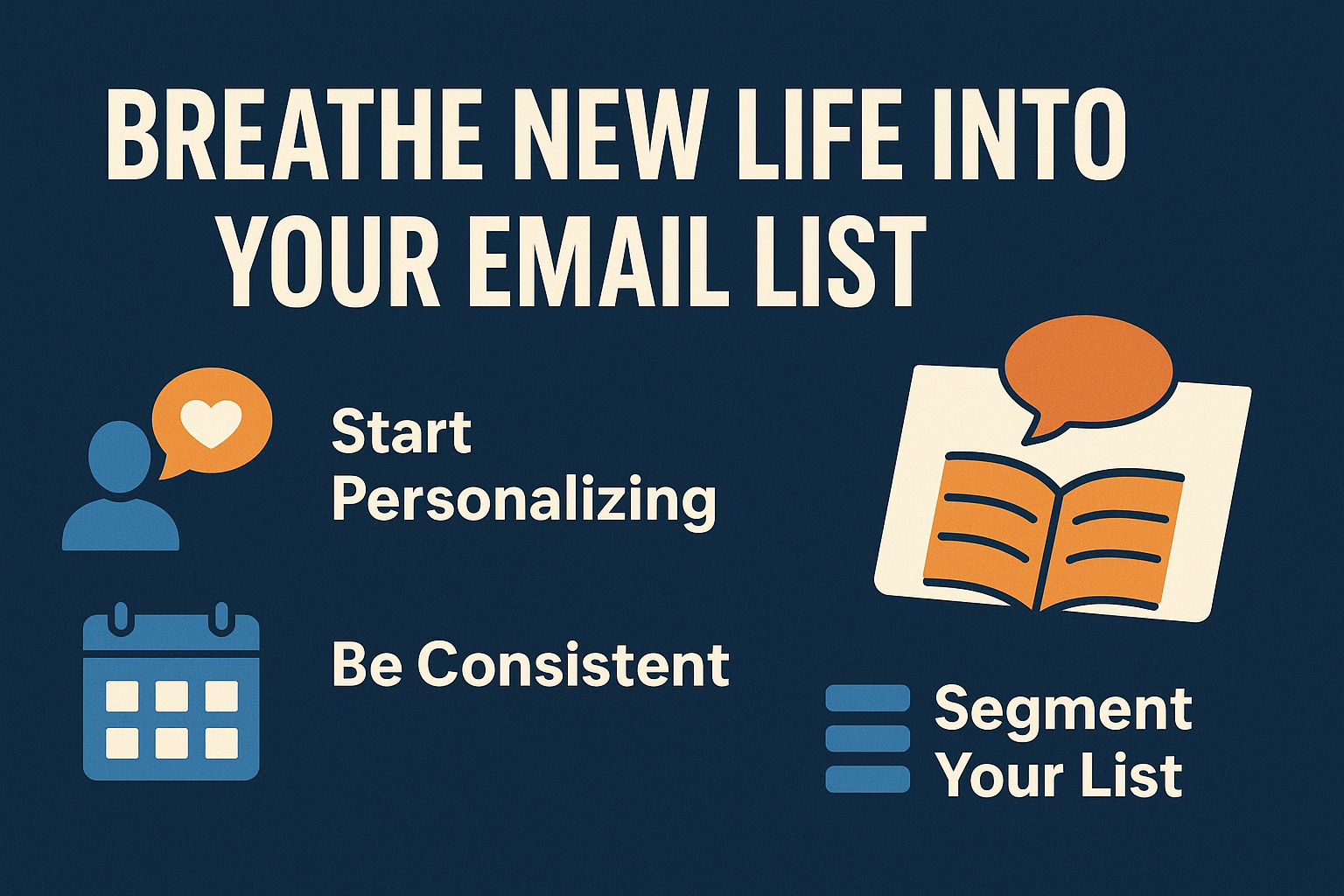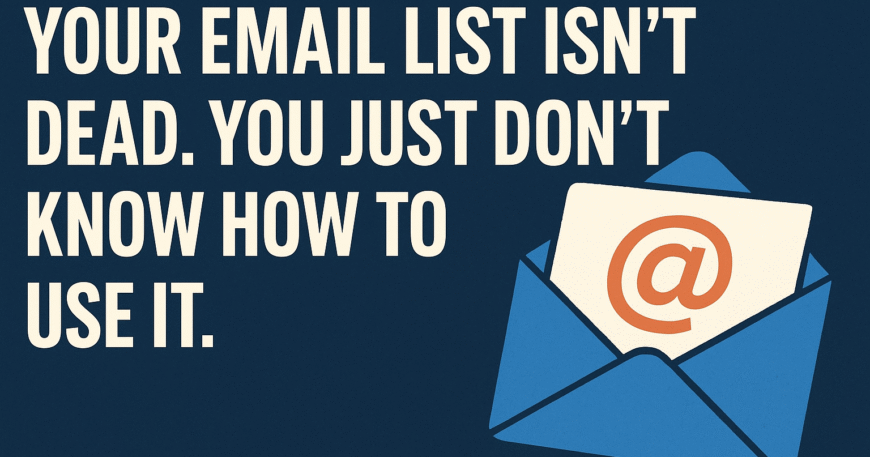Table of Contents
- The Myth of the “Dead” Email List
- Where Most Businesses Go Wrong
- The Power of Personalization
- Why Storytelling Wins in the Inbox
- The Role of Consistency in Engagement
- The Shift from Selling to Serving
- Re-Engagement: Bringing Back Silent Subscribers
- How to Bring Your Email List Back to Life
- The Bottom Line
For years, marketers have debated whether email marketing is “dead.” With the rise of social media, instant messaging, and AI-driven chat tools, many businesses assume their email list no longer works. But here’s the truth: your email list isn’t the problem — your approach is.
The real mistake most businesses make is sending generic, lifeless campaigns that fail to connect with their audience. Emails that lack personalization, storytelling, and context don’t get opened, don’t get read, and don’t convert.
Let’s break down why your email list still holds untapped power — and how to unlock it.
The Myth of the “Dead” Email List
Marketers often complain:
- “Open rates are down.”
- “People don’t read emails anymore.”
- “Social media works better than email.”
But the data tells a different story. Email marketing still delivers one of the highest ROIs of any digital channel — $36 for every $1 spent. The real issue isn’t that your subscribers don’t want to hear from you. It’s that you’re not giving them a reason to care.
Where Most Businesses Go Wrong
Here are the biggest mistakes that make an email list feel “dead”:
Generic blasts: Sending the same message to everyone, regardless of their needs or interests.
Lack of story: Emails that read like advertisements instead of conversations.
No consistency: Sporadic communication that trains your audience to ignore you.
Over-selling: Constantly pushing offers instead of adding value.
When emails feel robotic or irrelevant, people tune out. That doesn’t mean your list is dead — it means your strategy is.
The Power of Personalization
Personalization goes beyond using someone’s first name in the subject line. It means:
- Sending content that matches a subscriber’s stage in the buyer journey.
- Recommending resources or solutions based on past behavior.
- Creating segments for different industries, roles, or interests.
For example, an Oracle Cloud consultant doesn’t need the same email as a Workday HR manager. By segmenting your list and tailoring your message, you instantly make your emails more relevant.
Why Storytelling Wins in the Inbox
Facts inform. Stories connect.
When your emails include real stories — customer success, lessons learned, behind-the-scenes insights — your audience leans in. A story-driven email builds trust, positions your brand as human, and makes readers feel something. And emotions, not logic, are what drive clicks and conversions.
A dull announcement email might get ignored. But a story about how a client overcame a challenge (and how your solution played a role) can spark curiosity and engagement.
The Role of Consistency in Engagement
Many marketers underestimate how important consistency is in keeping their email list alive. Sending one email today, another three months later, and then vanishing again will only confuse your audience. Consistency creates familiarity, and familiarity builds trust. Think of it like building a friendship: you can’t disappear for months and expect the relationship to thrive. A steady rhythm — whether weekly, biweekly, or monthly — keeps your brand present in your subscriber’s mind without overwhelming them.
Consistency also conditions your audience to expect value. If every email you send feels meaningful, your readers begin to look forward to hearing from you. On the flip side, inconsistency trains them to ignore your messages because they don’t know when or why you’ll show up in their inbox.

The Shift from Selling to Serving
One of the biggest reasons businesses believe their email list doesn’t work is because they treat it as nothing more than a sales channel. Constantly pushing discounts, offers, or pitches is the fastest way to fatigue your list. Instead, think of email as a service channel — a way to educate, guide, and provide genuine value.
When you share industry insights, practical tips, or behind-the-scenes lessons, you give your audience a reason to keep opening. Selling becomes easier when trust is already built, and trust is built by serving first. In fact, brands that prioritize value-based emails over purely promotional ones consistently see higher engagement rates and stronger long-term customer loyalty.
Re-Engagement: Bringing Back Silent Subscribers
Even if your list feels “cold,” it doesn’t mean it’s beyond saving. A well-designed re-engagement strategy can bring silent subscribers back to life. Start by acknowledging their absence and offering something that reignites interest — a free resource, a quick survey, or a special piece of content just for them. Use subject lines that spark curiosity or empathy, like “We miss you” or “Is this goodbye?”
More importantly, re-engagement campaigns give you clarity. Those who interact again show they still want to hear from you, while those who remain silent help you clean and refine your list. A smaller but more engaged audience is always better than a large, unresponsive one.
How to Bring Your Email List Back to Life
Here are three practical ways to revive your “dead” list:
Audit your emails: Look at the last 10 campaigns you sent. Were they personalized? Did they tell a story? Or were they just promotions?
Segment wisely: Don’t treat all subscribers the same. Group them by behavior, industry, or stage of engagement.
Mix content types: Blend storytelling with value-driven content — tips, insights, and occasional offers.
By approaching email as a relationship tool, not a sales megaphone, you’ll start to see higher open rates, clicks, and conversions.
The Bottom Line
Your email list isn’t dead — it’s waiting. Waiting for you to stop treating it like a billboard and start treating it like a conversation. The moment you shift from generic blasts to personalized, story-driven communication, you’ll realize the untapped potential sitting in your inbox.
So next time you’re tempted to blame your “inactive” list, remember: it’s not about the size of your list, but how well you use it.




